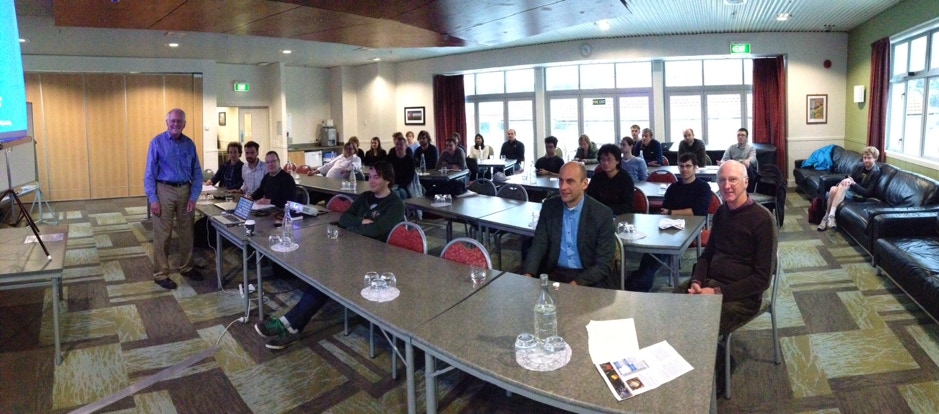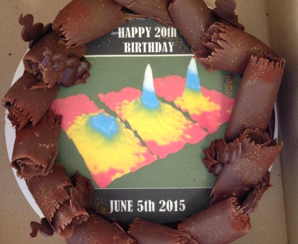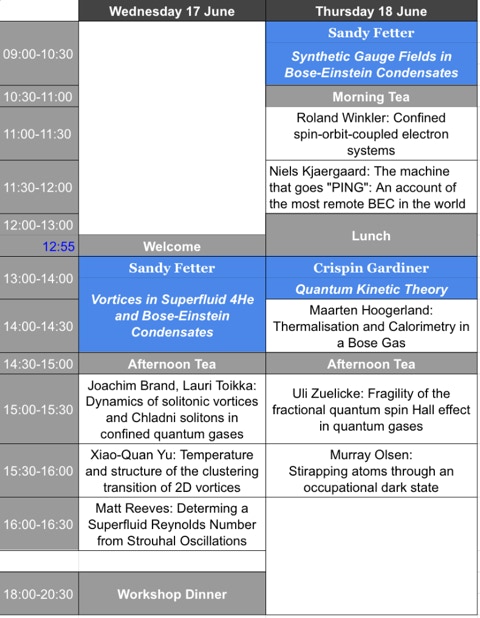-
SCIENCE
-
QUANTUM CURIOUS
-
NEWS/EVENTS
-
PEOPLE
Quantum Theory

A workshop on hot topics in ultra-cold gases.
Introductory lectures on two topics were presented by Professor Sandy Fetter. An invited talk on Quantum Kinetic Theory was presented by Professor Crispin Gardiner.
The meeting was held at
Arana College, 110 Clyde Street (see the map below).

Presentations available in PDF format:
Vortices in Superfluid Helium and Bose-Einstein Condensates (Sandy Fetter)
Synthetic Gauge Fields in Bose-Einstein Condensates (Sandy Fetter)
Quantum Kinetic Theory (Crispin Gardiner)
Confined Spin-Orbit Coupled Electron Systems (Roland Winkler)
Fragility of the Fractional Quantum Spin Hall Effect in Quantum Gases (Ulrich Zuelicke)
Stirapping Atoms Through an Occupational Dark State (Murray Olsen)
Calorimetry and Thermalisation of a Bose Gas (Maarten Hoogerland)
Dynamics of solitonic vortices and Chladni solitons in confined quantum gases (Joachim Brand, Antonio Mateo)
Introductory Lecture
Synthetic Gauge Fields in Bose-Einstein Condensates
Sandy Fetter, Stanford University
I review the physics of two-component trapped spin-orbit coupled Bose Einstein condensates as created by the NIST group. Specifically, I focus on the dynamics of a vortex in such a two-component condensate.
I then consider synthetic gauge fields in optical lattices, dealing with three particular mechanisms: (1) time-dependent modulations (“shaken lattice”), (2) laser-assisted tunneling to create Harper-Hofstadter square two-dimensional lattice in an applied magnetic field with flux 1/2 per plaquette, and (3) synthetic dimensions involving internal atomic states. In each case, I explain the synthetic vector potential and the associated complex phase of a hopping amplitude in the tight-binding Hamiltonian.

Introductory Lecture
Vortices in Superfluid Helium and Bose-Einstein Condensates
Sandy Fetter, Stanford University
I review the basic physics of superfluid 4He, especially quantized vortices, and then describe dilute quantum gases, particularly Bose-Einstein condensates (BECs). The dynamical motion of an off-axis single vortex in a BEC provides a clear test of theoretical predictions; experiments confirm these ideas in considerable detail at the 5-10% level. I review various experiments that create and detect vortices in BECs.
With increasing external rotation of the condensate, the BEC has many vortices, typically arranged in a triangular lattice. If the vortices are well separated, a simple mean-field description suffices. For more rapid rotation, the vortex cores start to overlap, and a “lowest-Landau-level” picture becomes appropriate; it includes the local variation of the particle density.
For sufficiently rapid rotation, the system is predicted to undergo a quantum phase transition to a highly correlated state, similar to a bosonic analog of the Laughlin 1/3 state for the fractional quantum Hall state of an electron gas in a strong magnetic field. Such a correlated state would not have a condensate wave function and hence would not be superfluid. This transition has not yet been observed, but it would be highly interesting.
Venue
Local organizer and chair
Proudly sponsored by
ABOUT QSO
The Centre for Quantum Science is a University of Otago Research Centre hosted by the Department of Physics.
CONTACT
Ashton Bradley
ashton.bradley [at] otago.ac.nz
Niels Kjærgaard
niels.kjaergaard [at] otago.ac.nz